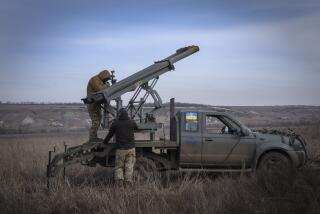Disposal of Chemical Arms in U.S. Lags as Costs Mount
WASHINGTON — The nation’s chemical weapons stockpiles, perceived as a potential security threat following the Sept. 11 terrorist attacks, will cost billions of dollars more and take years longer to destroy than the Army has previously told Congress and the public, according to government records and Pentagon officials.
After insisting that the Army was on schedule with the destruction of the weapons, defense officials have privately acknowledged that significant delays and dramatic overruns will raise the price of the program by about $9 billion and push its completion well past an international treaty deadline of 2007, according to an internal memo obtained by The Times.
This would come as unwelcome news to communities where the weapons are stored and where there is already uneasiness about the risk that an accident or an attack could unleash a deadly cloud of nerve or mustard agents. This last week, hundreds of Army troops were dispatched to guard the stockpiles at eight chemical weapons depots throughout the U.S.
At the same time, terrorism fears could change the political dynamics of the debate over incineration, the Army’s preferred disposal method. The desire to eliminate the weapons as quickly as possible could help the Army overcome resistance to incineration in communities where that battle is being fought. The concerns could also lead to expedited environmental reviews.
The ballooning costs and timetables are likely to prompt fresh criticism of the program to eliminate the nation’s 31,496 tons of chemical weapons. In recent months, members of Congress and other critics have accused top Army officials of duplicity for understating the price tag and time needed to destroy the lethal munitions.
Interviews and documents obtained by The Times show that senior officials have concluded that costs will ultimately rise to about $24 billion, up from an earlier estimate of $15 billion. Pentagon sources said the revised timetables are expected to show that work will not be completed at some of the sites until between 2008 and 2012.
The updated estimates were developed as part of a high-level Pentagon review of the weapons disposal program. A senior Pentagon official said the review has confirmed that Army officials have long realized that the projected cost of $15 billion and the 2007 deadline were far too rosy.
“People have known for a long time that wasn’t going to happen,” said the official, who spoke on the condition of anonymity.
The Army denies it provided misleading estimates.
Millions of rockets, bombs and projectiles, along with drums of nerve and blistering agents, await destruction at weapons sites in eight states. They are stored in igloo-like concrete bunkers that are covered by earthen mounds and surrounded by barbed wire and armed guards. Many were produced 50 years ago or earlier.
The Army has already destroyed more than 23% of its chemical weapons at incinerators in Tooele, Utah, and at Johnston Atoll in the Pacific.
Additional incinerators are under construction at weapons sites in Anniston, Ala., and near Umatilla, Ore. and Pine Bluff, Ark. Chemical neutralization plants are being built to destroy liquid agent stockpiles at Newport, Ind., and Aberdeen, Md. At the remaining sites--Pueblo, Colo., and Blue Grass, Ky.--a disposal method has not yet been chosen.
Program Repeatedly Came Under Fire
The overruns are the latest blow for a program that has repeatedly come under fire from government investigators, Congress and environmental groups. The $24 billion figure represents a 14-fold increase from an original estimate of $1.7 billion when the program began in 1985. At the time, the Army said it would complete destruction by 1994 of the stockpiles of mustard gas, sarin and VX nerve agent, along with rockets, land mines and other delivery systems.
An international chemical weapons treaty, ratified by the U.S. in 1997, requires that weapons stockpiles be destroyed by 2007, but provides a five-year extension for countries that cannot finish on time. Russia, which has a larger chemical weapons stockpile than the U.S., has said it will seek this additional time.
The new estimate of $24 billion was cited in a Sept. 6 memorandum by a top aide to Edward C. “Pete” Aldrich, undersecretary of Defense for acquisition, technology and logistics. The memo, which was obtained by The Times, summarizes the findings of a Pentagon team that completed its review of the program this summer.
The revised numbers will provide new ammunition for watchdog groups near some of the weapons sites, who say the military has used the treaty deadline and threat of leaks from aging munitions to steamroll opposition to incinerators. Some environmentalists are pushing the Army to embrace chemical neutralization as a safer alternative because incineration invariably releases traces of toxic substances into the air. And some communities--particularly Anniston, where 75,000 residents live within nine miles of a nearly finished incinerator--want more money for emergency preparedness in case of a major accident.
Pentagon officials said Friday they were not authorized to discuss the new projections until they were publicly released.
Marilyn Daughdrill, spokeswoman for the Program Manager for Chemical Demilitarization, a branch of the Army that oversees the destruction of the weapons, said Army officials had not misled Congress or the public but had provided official estimates for costs and timetables as they were available.
One of the program’s harshest detractors, Sen. Mitch McConnell (R-Ky.), disagreed.
“They’ve made every mistake in the book: poorly run, behind schedule and deceptive on top of it,” he said. The Pentagon “may need to clean that office out and start all over again.”
Fears of Terrorist Use Heightened
The Sept. 11 assault has raised concerns that the chemical weapons could be targeted by terrorists seeking to steal some of the munitions or blow up them up by hitting them with a hijacked airplane.
As a precaution, the Army assigned 100 to 200 troops to each of the chemical weapons depots on Sept. 25 to reinforce already beefed-up security. They are to remain indefinitely, officials said.
Defense officials declined to discuss any impact that the heightened security concerns might have on the program.
Michael A. Burney, the executive director of the Emergency Management Agency in Calhoun County, Ala., which includes Anniston, said his office has received 60 to 70 calls daily since Sept. 11 from people asking where they can purchase gas masks and expressing other concerns.
He said he was “appalled” to learn that Anniston might have to live with the munitions beyond the 2007 treaty deadline. He said this will put an added burden on the county to prepare for a possible chemical incident over a longer period.
Even the $24 billion figure could prove optimistic. If Congress does not approve anticipated levels of funding, the final cost could go higher and the timetable could slip further, a Pentagon official said.
Efforts to reach Aldrich and James Bacon, who heads the chemical weapons disposal program, were unsuccessful. Defense officials said Friday morning they could not comment on the new projections because Aldrich had yet to approve them.
Later Friday, Henry C. Dubin, the Army’s deputy assistant secretary for chemical demilitarization, said that Aldrich had signed a revised set of estimates on Sept. 26. But he said he was unable to provide them or any further information about the final projections.
The higher costs do not include the additional billions that will be needed to pinpoint and clean up more than 200 disposal sites where wastes from chemical weapons were buried decades ago. The international treaty does not cover such sites, though Army officials acknowledge the dumps must be dealt with as well.
Memo Cites Reasons Work Will Take Longer
The Sept. 6 memo does not include a new timetable, but states that after the original deadline of 2007, $6.7 billion more will be needed to finish the work. There is no date for concluding work at the Colorado and Kentucky sites, where a disposal method has not been chosen.
The memo to Aldrich cited several reasons the work will require more money and time. One is that officials have learned from experience at the existing incinerators that the rate at which the weapons can be burned is lower than expected. Other factors cited were delays in obtaining environmental permits and higher costs for labor and equipment and to contain leaks in aging stockpiles.
Some defenders of the Army say Congress is partly responsible for the delays and higher costs. Over the years, lawmakers have directed the Army to expand emergency preparedness programs and to research and develop alternate waste-destruction technologies.
The Sept. 6 memo said Defense officials are also considering a proposal to give Army contractors who operate the sites new financial incentives to beat cost and timing targets.
Although the details were not spelled out in the memo, it acknowledged such an incentives plan would be controversial. The memo noted that critics would see such incentives as an invitation to contractors to take shortcuts, but added that “a bonus would not be paid if safety or environmental performance were unsatisfactory.”
The internal documents contrast with the stance taken by senior Army officials last spring when they assured Congress that the program was on track.
Appearing April 25 before a Senate panel, acting Secretary of the Army Joseph Westphal and program manager Bacon acknowledged that the Pentagon was reassessing costs and completion dates. But they said they believed the $15-billion price was in the ballpark, and that they would be able to destroy virtually all the chemical weapons by 2007.
“By 2007, actually 2006, we will meet the chemical weapons convention in destruction of all the chemical warfare material,” Bacon told the panel.
Testimony Called Deliberately Misleading
Critics, led by Craig Williams of the Chemical Weapons Working Group, which opposes incineration, claimed the testimony was deliberately misleading. After Westphal and Bacon left the hearing, Williams presented lawmakers with a leaked Army report showing that, based on the Army’s experience to date, incinerators couldn’t process the rockets and other munitions as quickly as anticipated.
As a result, Williams testified, since at least October 2000, when the report was completed, the Army had known it would be impossible to stick to its schedule and costs.
The Army issued a statement after the hearing defending its estimates and calling William’s numbers a “worst-case scenario.”
The Army’s Daughdrill said Friday that Westphal and Bacon “didn’t have any concrete information in April that definitively said there had been any changes at that point.”
But a senior defense official, in an interview with The Times, said the Army’s testimony had been misleading. “It approached the level of lying to Congress,” he said.
Williams said that the new internal estimates confirm that the Army knew before the April hearing “that the schedule they were presenting and the costs they were presenting were bogus. The whole thing is a shell game.”
More to Read
Sign up for Essential California
The most important California stories and recommendations in your inbox every morning.
You may occasionally receive promotional content from the Los Angeles Times.










